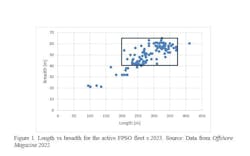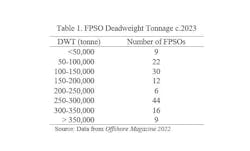Dimensions, deadweight key factors in determining FPSO hull size and shape
By Mark J. Kaiser, Louisiana State University
FPSO hulls are typically described in terms of their dimensions, shape, volume (storage capacity), displacement, and deadweight. The goal here, in the third part of this FPSO series, is to show that FPSO dimensions and deadweight correlate in a robust fashion, so that knowledge of one parameter implies the other.
The main factors that determine the size and shape of an FPSO hull are the environmental conditions expected and motion characteristics, topsides weight, storage capacity, and layout requirements. One factor may dominate the requirement or several considerations may prevail.
Hull dimensions
Hull dimensions include length L, breadth (width or beam) W, and depth D (sometimes also called height).
FPSOs are slender body vessels and most of the fleet has lengths between 200-370 m and breadth between 40-65 m (Figure 1). Length-to-beam ratios for FPSOs generally range from 5.5 to 6.5.
Length overall is measured from the foremost point of a ship’s bow to the aftmost part of its stern. Breadth is a ship’s width at its widest point. Depth is the freeboard plus draft, where freeboard is the deck height above water level. Draft denotes the depth below the sea level of the lowest point of the structure, the vertical distance from the waterline down to the keel.
Length and breadth are correlated dimensions which fall within characteristic bounds for different ship types. For FPSOs, length and breadth reflect the characteristics of tanker conversions and the needs for storage and motion stability at site.
FPSO conversions inherit their dimensions from converted tankers, but hull modifications are sometimes made to expand breadth; for newbuilds, dimensions are field specific and are often more block shaped.
Deadweight
Deadweight tonnage (DWT) is the displacement of a fully loaded ship at maximum draught, minus the lightship displacement (hull weight). Or, in other words, DWT represents the maximum weight the vessel can carry without exceeding its maximum design draft.
According to the FPSO poster data from the November/December 2022 Offshore, about one fifth of the active FPSO fleet has DWT < 100,000 tonnes (t); about one fifth falls above 300,000 t; and the remaining 60% of the fleet has deadweight between 100,000 and 300,000 t (Table 1).
Dimensions x deadweight
FPSO deadweight correlates with hull length L, hull effective area (L*W), and hull block volume (L*W*D) (Figure 2).
Length alone provides a reasonably good predictor of deadweight:
DWT = 1508 L– 228,974, R2 = 0.68
With the addition of vessel width and depth, the model relations improve significantly:
DWT = 19.7 L*W– 87,254, R2 = 0.83
DWT = 0.55 L*W*D– 16,270, R2 = 0.87.
Deadweight is reported in tonnes. All dimensions are in meters.
Developing a model
Fixed-term models are constructed to illustrate model fit, as it is commonly understood and interpreted, but models that pass through the origin (i.e., no fixed term) may be preferred since the fixed term has no obvious interpretation and model comparisons are less direct and meaningful with fixed-term parameterizations.
Without fixed terms, the deadweight and dimension models are as follows:
DWT = 737 L, R2 = 0.90
DWT = 14.3 L*W, R2 = 0.95
DWT = 0.52 L*W*D, R2 = 0.97.
Comparing the coefficients of the model types, those with and those without fixed terms, we see that models with a negative fixed term have a smaller coefficient of the corresponding slope (as they should) relative to models through the origin.
Model extensions are easy to perform and, in some cases, may lead to improvement. For example, identifying FPSOs as single or double-hulled using subgroups or an indicator variable could be explored.
Block hull volume
FPSO block hull volume (L*W*D) used in the above models should not be confused with the actual hull volume, which will be smaller since tanker hulls cut the water at an angle and often have a curved shape (at least for FPSO hulls converted from tankers).
In naval architecture, form coefficients are used to represent the shape of the underwater hull and one of the most useful form coefficients is called block coefficient defined as V/LWD, where V is the actual hull volume.
The block coefficient describes how “full” the underwater portion of the hull is, and generally ranges from 0.5-0.9.
Slender hulls with less underwater volume have block coefficients near the low end of the range; these are fast ships and racing yachts.
Cargo ships have wider hulls with more underwater volume and approach the high-end of the range. Tankers and FPSO hulls typically have block coefficients between 0.85-0.88, with newbuilds having greater block coefficient values than converted tankers.
Editor's note: This article is part three of a five-part series in which Mark Kaiser examines some of the principal features of FPSO units and how they relate across the fleet. In the first part, the current inventory and lifecycle dynamics of FPSOs are reviewed. In Part 2, he classifies FPSOs using the equipment gas-oil ratio and shows how installations have evolved over time to handle more volatile crudes and gassier fields.
About the Author

Mark J. Kaiser
Center for Energy Studies
Mark J. Kaiser is Professor at the Energy Institute at Louisiana State University. His research interests cover the oil, gas, and refining industry, and relate to cost assessment, fiscal analysis, infrastructure modeling, and valuation studies. Kaiser has led several studies and published extensively on decommissioning in the Gulf of Mexico. He holds a Ph.D. from Purdue University.



